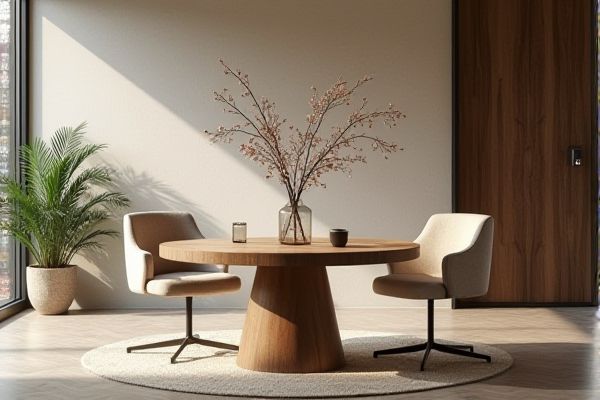
Round tables offer a more inclusive and intimate seating arrangement, promoting easier conversation and equal participation among guests, while oval tables provide a similar effect with a bit more surface area and flexibility in seating capacity. Discover which table shape perfectly suits your space and hosting style by reading the rest of the article.
Table of Comparison
| Feature | Round Table | Oval Table |
|---|---|---|
| Shape | Perfect circle | Elongated circle with rounded ends |
| Seating Capacity | Comfortable for 4-6 people | Accommodates 6-8 people easily |
| Space Efficiency | Ideal for small spaces | Better for narrow or longer rooms |
| Social Interaction | Promotes equal conversation flow | Encourages conversation between ends but less central |
| Design Style | Casual and modern | Elegant and traditional |
| Use Case | Small gatherings, kitchens | Formal dining, larger groups |
Introduction to Round and Oval Tables
Round tables offer equal seating arrangements that encourage conversation and social interaction, making them ideal for smaller spaces and intimate gatherings. Oval tables, with their elongated shape, provide more surface area while maintaining a sense of inclusivity and can accommodate larger groups comfortably. Choosing between these two depends on your space, seating needs, and the atmosphere you wish to create.
Key Differences Between Round and Oval Tables
Round tables have a perfectly circular shape, promoting equal seating and fostering inclusive conversation by eliminating head positions. Oval tables, with their elongated, elliptical design, provide more surface area and can accommodate larger groups while still encouraging interaction. The choice between round and oval tables depends on the balance between space efficiency and the need for expanded seating capacity in dining or meeting areas.
Aesthetic Appeal: Round vs Oval Table Designs
Round tables offer a balanced and symmetrical aesthetic that promotes intimacy and a cohesive design flow in any space. Oval tables combine the smooth curves of round tables with an elongated shape, providing a visually pleasing blend of softness and spaciousness ideal for accommodating more guests. Both designs enhance room dynamics, with round tables emphasizing unity and oval tables adding elegance and versatility to interior layouts.
Space Efficiency and Room Layout Considerations
Round tables maximize space efficiency by allowing seating without sharp corners, promoting easy movement around the table and fitting well in smaller or irregularly shaped rooms. Oval tables offer more surface area than round tables of similar width, accommodating more seating while maintaining smooth edges that complement elongated or narrow spaces. Your choice depends on optimizing room layout for traffic flow and balancing seating capacity with available floor space.
Seating Capacity and Comfort Comparison
Round tables typically offer a more intimate seating arrangement, comfortably accommodating 4 to 8 people without a designated "head," promoting equal conversation flow. Oval tables can seat more guests, ranging from 6 to 12, with extended length providing additional space for larger gatherings while maintaining a softer profile than rectangular tables. Oval shapes balance seating capacity and comfort by allowing slightly more elbow room and movement compared to round tables, especially in longer configurations.
Best Uses for Round Tables in Various Settings
Round tables promote equal conversation flow, making them ideal for small meeting rooms, intimate dining areas, and collaborative workspaces where inclusivity is key. Their shape maximizes seating capacity in compact spaces, enhancing communication without crowding your environment. Choosing a round table supports dynamic interactions and fosters a sense of community in both residential and professional settings.
Ideal Situations for Oval Tables
Oval tables are ideal for narrow dining rooms or spaces where maximizing seating capacity without sharp corners is essential. Their elongated shape allows for better flow in tight areas while creating a more intimate dining experience compared to round tables. You can comfortably accommodate more guests at an oval table, making it perfect for family gatherings or formal dinners.
Durability and Material Options
Round tables often feature sturdy hardwoods like oak and maple, providing excellent durability for long-term use in various settings. Oval tables offer similar material versatility but sometimes incorporate metal or glass elements for a modern aesthetic that balances strength and style. Both table shapes benefit from quality finishes and construction techniques that enhance resistance to wear, ensuring lasting performance.
Price Comparison and Budget Considerations
Round tables often come at a lower price point compared to oval tables due to simpler manufacturing processes and less material use. Oval tables, typically larger and more elaborate, may require a higher budget but offer more seating capacity and versatility for your space. When considering price comparison, factor in not only the upfront cost but also durability, style, and how the table fits within your budget constraints.
How to Choose Between a Round and Oval Table
Choosing between a round and oval table depends on available space, seating capacity, and room shape. Round tables maximize social interaction with equal seating but suit smaller or square rooms, while oval tables offer more surface area and fit well in narrow or elongated spaces. Prioritize table dimensions, ease of movement, and the desired ambiance for dining or meetings to make the best choice.
 homyna.com
homyna.com